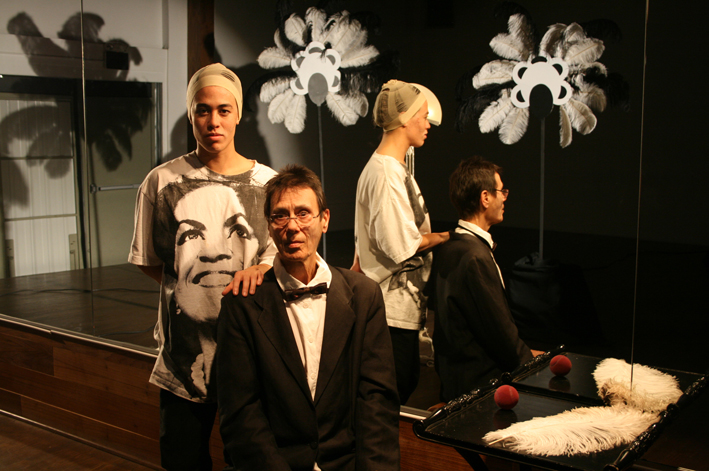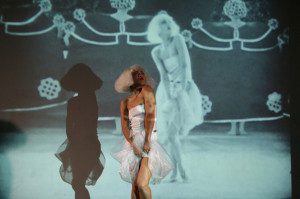《莎乐美之狂》
Salomania
2009 | 17min | 波林·宝得瑞 / 瑞纳特·劳伦茨 Pauline Boudry / Renate Lorenz
实验短片Experimental Film
主演 Cast
Yvonne Rainer, Wu Ingrid Tsang
摄影 Cinematographers
Michelle Lawler, Micki Pocklar
对白语言 Language
English
字幕 Subtitles
中英 Chinese, English
故事梗概 Synopsis
“莎乐美”重现了“莎乐美的七层纱”这段来自艾拉·娜兹莫娃1923年的默片电影《莎乐美》中的舞蹈 。同时影片中也展现和排演了舞蹈家和电影制作人依冯·瑞娜在观看了娜兹莫娃的电影之后所做的“瓦尔达独奏”。作品则将莎乐美作为了一个异族变性者和同性恋的符号。影片中的表演者为依冯·瑞娜和吴·英格丽·曾。
在20世纪初曾出现过一股对于莎乐美的狂潮被称为“莎乐美之狂”。女人们聚在一起模仿“莎乐美的七层纱”这段舞蹈。一系列的关于她们对于莎乐美诠释的舞蹈变得出名。也成了同性恋者独立和性自由的符号。
Salomania reconstructs a dance, the “dance of the seven veils,” from Alla Nazimova’s 1923 silent film Salomé. Also shown and rehearsed are sections from “Valda’s Solo,” which choreographer and filmmaker Yvonne Rainer created after having seen Nazimova’s film. The installation takes up Salome as a transgender figure and the motif of a queer appropriation of the exotic. The performers are Wu Ingrid Tsang and Yvonne Rainer.
At the beginning of the 20th century there was a wave of excitement about the character of Salome, who soon earned the name ‘Salomania.’ Women would get together and imitated the dance of the seven veils. A series of dancers became famous for their interpretations of Salome. The figure of Salome stood for entrepreneurial independence and sexual freedom and became an icon of “sodomite” subjectivity.
导演简介 Bio-Filmography of Directors
波林宝得瑞和瑞纳特劳伦茨为居住在柏林的艺术家,她们从2004年开始合作。她们的视频装置作品重探历史时刻。这些历史时刻通常是在影像评论史中不具典型性并且难以辨认的酷儿历史。 她们的电影聚焦个人和群体行动,挑战世俗、法律和经济。以制造镜头前的戏剧性,她们不讨好规范的历史性描写,同时涵盖不同时期的表演、投射和形象。与众不同的对待影像的方式,她们对电影的使用成为自身表演的模本。她们流畅有趣的影像为她们带来广泛的国际认可。
Pauline Boudry / Renate Lorenz are an artist duo based in Berlin who have worked together since 2004. They produce film installations that revisit historical moments and often-unrepresented or illegible queer histories, with a particular interest in a critical history of the photographic and moving image itself.Their films stage the actions of individuals and groups living—indeed thriving—in defiance of convention, law and economy. Producing plays for the camera, they upset normative historical narratives and inclusions through the staging, projection and layering of moments and figures across time. Their distinctive treatment of the moving image, their use of film loops as a mode of performance in itself, and the fluency and pleasure of their cinematography has gained them widespread international acclaim.
导演阐述Directors’ Statement
无声电影《莎乐美》来源于王尔德根据圣经中犹太公主莎乐美德故事创作的戏剧《莎乐美》。希律王想要他年轻的继女莎乐美。但她喜欢上了拒绝她的先知约翰。于是莎乐美答应了想要看她舞蹈的国王,并以此交换约翰的头颅。最终她得到了头颅并亲吻了他。
这件作品灵感来源于默片,同时使用了例如凝视、对莎乐美的欲望、面纱的图像,但同时也包含了一些装饰艺术的元素。这些设计风格是二三十年代出现的现代流行材料和科技图像。但是为什么这其中混合了东方主义的材料和形象,例如鸵鸟羽毛和棕榈树?
这些“遥远的”图像和使用的技术可以被视为殖民主义的一部分,从而进一步的使观众熟悉殖民地的“外国人”。但是,同时通过莎乐美的电影,他们也试图为殖民控制进行辩护。这里他们通过图像为女性和异装癖者建立了一个空间。这个可能性的空间在性别和东西方之间出现。
The script of the silent film Salomé is based on the play of the same name by Oscar Wilde and follows the Biblical story of the Jewish princess Salome. King Herod desires his youthful stepdaughter Salome. She in turn is interested in the missionary Jokanaan (the Baptist), who, however, rejects her. She gives in to Herod’s desire to see her dance, then demands the head of Jokanaan on a platter as a reward. She kisses the severed head.
The installation ‘Salomania’ takes up motifs from the silent movie, such as gazes, the active desire of Salome, and the figure of the veil, but also elements of Art Deco, which the movie celebrates. This prevailing design style of the 20s and 30s applied modern materials and images of technological progress. But why have they been mixed with “Oriental” material and images such as ostrich feathers and palm trees?
While images of “farness” and the technological can be seen as part of colonial politics—further familiarizing spectators with the “foreignness” of the colonies, but also seeking to justify colonial domination—at the same time they have been transformed by the film Salomé. Here they are established as images that make space for female or “transvestic” fantasies and desires. A space between the genders and between Orient and Occident appeared to be possible.



